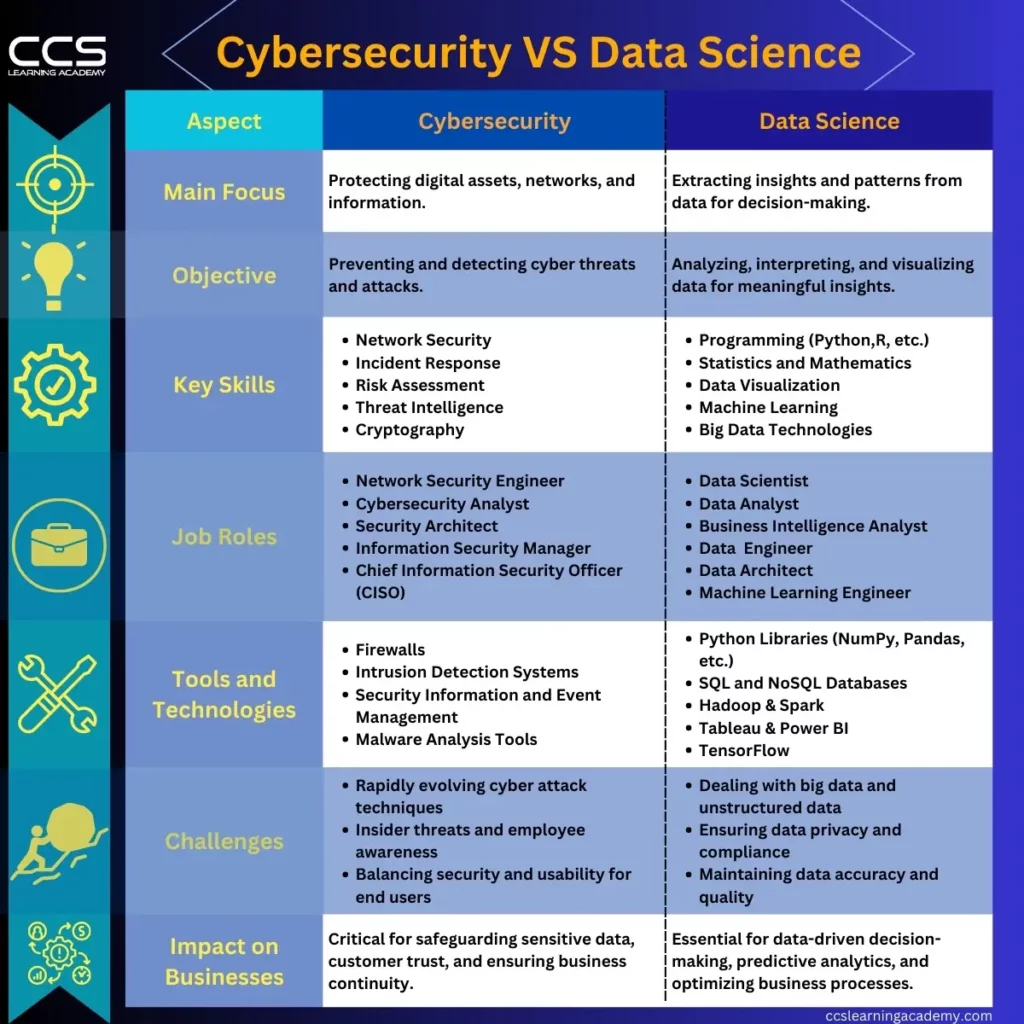Cybersecurity vs. Data Science: Your Ultimate Career Guide for 2023
In today’s rapidly advancing world, a strong network of high-secured data is what businesses demand. Cybersecurity and data science have emerged as two prime fields that play a major role in guarding and maximizing the value of data.
While data science is a combination of high-level mathematics and statistics that allows us to gain important insights from data, cybersecurity’s role is to protect this data and prevent unauthorized access to it.
Both cybersecurity and data science have been topics of debate among experts today. Although this fact cannot be denied, both of these fields are equally important for the use of data. While data insights help us move in the right direction, safeguarding them ensures that no sensitive information is ever compromised.
A study says that by 2025, cybercrimes will cost us $10.5 trillion annually. This shows a heavy loss for the tech industry.
In this blog post, we will discuss the major aspects of cybersecurity and data science, their job opportunities, and how both fields differ from one another in terms of responsibilities, objectives, and other essential aspects.

Table of Contents
A Comprehensive Analysis of Cybersecurity
The practice of protecting computers, networks, software, and data from various threats and attacks to maintain confidentiality, integrity, and availability is referred to as cybersecurity. It includes a variety of safeguards designed to protect digital systems and sensitive information from unauthorized access, data breaches, and other malicious activities.
Data is one of the most valuable assets in today’s digital landscape. Cyberattacks can result in financial losses, reputational harm, and invasions of personal privacy. To prevent and lessen the effects of these attacks and guarantee the security and privacy of sensitive data, cybersecurity is essential.
Cybersecurity threats have been the primary motivators for governments, individuals, and organizations to spend large sums of money to protect their privacy. Every year, the world spends approximately $219 billion on cybersecurity needs, and figures are expected to reach $300 billion by 2026.
Key Components of Cybersecurity
Cybersecurity involves a lot of components that together ensure the overall security of data for an organization or individual.
- Threats and Vulnerabilities: Cybersecurity involves dealing with numerous threats that include malware, ransomware, phishing attacks, and others that tend to exploit the vulnerability of a system and take advantage of it. Therefore, addressing vulnerabilities and leaving no loopholes behind is an essential component of cybersecurity.
- Risk Management: Every attack on a system has its risks. Different cyberattacks pose different risks to a system. Therefore, understanding the risks associated with a cyberattack and taking necessary action against it is essential.
- Security Measures and Protocols: Robust security measures such as encryption, firewalls, access controls, and multi-factor authentication are other important components of cybersecurity to ensure the safety of data and maintain privacy.
Role of a Cybersecurity Professional
Seeking a career in cybersecurity? You should be aware of the basic roles and responsibilities of a cybersecurity professional. For a layman, a cybersecurity professional’s only job is to ensure the safety of an IT infrastructure while also protecting software development. A cybersecurity professional plays an important role in the research and identification of potential threats, developing new security plans, and predicting the creative nature of hackers.
Key Responsibilities of Cybersecurity
Key responsibilities of cybersecurity professionals include
- Conducting security audits of the ongoing operations to make sure there are no invasions
- Creating and maintaining security policies so that software is built and operated responsibly
- Educating employees about best security practices to avoid potential data damage
- Quick response towards security incidents to overcome the situation with little to no loss
- And also proactively assessing and improving the organization’s security posture.
Detailed Exploration of Cybersecurity Implementation and Examples
Some of the common implementations involve establishing firewalls, setting up secure VPNs, performing vulnerability assessments, and conducting penetration testing to identify issues with the system. Some of the most common examples of cybersecurity accidents include ransomware attacks, phishing attempts, and DDoS attacks.
One of the prime examples of a Denial of Service (DDoS) attack happened with Amazon. In February 2020, Amazon experienced the largest DDoS attack. This attack would result in the compromise of a traffic volume of 2.3 Tbps although, its AWS shield mitigated the attack. This example perfectly demonstrates the importance of cybersecurity and how it is a crucial aspect of the digital era.
A Comprehensive Analysis of Data Science
Data science is concerned with providing an in-depth understanding of data through the use of mathematics and statistics, resulting in the development of meaningful patterns. These patterns can be used to predict the movement of data and make other informed decisions.
Data science has gained rapid popularity in recent years, and it is now one of the fastest-growing technologies in the world. Moreover, the U.S. Bureau of Labor Statistics has claimed the industry will grow by 22% by the year 2030. Therefore, now might be the ideal time for you to pursue a career in data science.
Key Components of Data Science
The need for data science in today’s world is immense. This is because we are in an era of digital transformation. Data is the ultimate source of information, and every piece of information is stored in the form of data. Therefore, ways are needed to handle such huge amounts of data effectively.
Data science, one of the most demanding technologies of the present day, deals with the following primary components.
- Data Collection and Analysis: Data science includes the gathering of reliable information from relevant resources. This information is gathered so that we can discover important facts and use them to generate predictions. Any meaningful and genuine source, including social networking sites, polls, and other techniques, might give this data.
- Machine Learning and Algorithms: To better utilize the information collected, data scientists apply machine learning techniques. These algorithms help in data classification and prediction across multiple datasets.
- Predictive Modeling and Data Visualization: Data science’s final step involves making predictions based on the gathered information. The collected data reveals a relevant pattern based on which future predictions can be made.
Role of a Data Scientist
A data scientist is responsible for
- Exploring the fresh and past data, analyzing the statistics and trends
- Creating models that provide elaborative outcomes
- Applying new algorithms to the data for refinements and sorting
- And interpreting results to provide actionable insights.
Data scientists work closely with stakeholders to understand business needs and help make decisions based on data-driven evidence.
Detailed Exploration of Data Science Implementation and Examples
Data science can be used in a variety of ways, such as developing recommendation systems, forecasting consumer behavior, examining social media trends, and streamlining business operations using data insights. Data science has helped a lot of companies take the upper hand in the market.
One of the most recent examples where data science came as a savior was when the well-renowned Johnson and Johnson company used it to track the patterns of the virus. The company made use of data to predict the areas that could be the hub of people affected by COVID-19. This helped in taking the necessary actions well ahead of time and mitigating the risk of infection.
Comparison Between Cybersecurity and Data Science
Cybersecurity and data science comparisons can be made on various grounds. While cybersecurity focuses on protecting data from unauthorized access and attacks, data science uses data to gain insights and support decision-making. Since both domains have different goals, let us consider the cybersecurity and data science differences by considering them as career options.
Here is a detailed comparison of every aspect of these two fields.
Understanding the Challenges and Ethical Considerations
Although cybersecurity and data science are important considerations in today’s technical world, there are a lot of challenges that come with the implementation of these two fields. Let us know about some of the prime challenges that come with data science and cybersecurity.
Balancing Privacy and Security
One of the major challenges when dealing with cybersecurity and data science is adopting measures that will prevent any unauthorized access to user data and respect their privacy.
In cybersecurity, it is necessary to adopt the correct access control options, yet it must be ensured that these procedures do not hinder the user’s data. Thus, maintaining the right balance becomes necessary where vulnerabilities are to be taken care of without putting the privacy of the user at stake.
Similarly, data science involves collecting and studying valuable and sensitive data from users. Although this data can provide valuable insights to enhance the security of the user, collecting such a huge amount of data must not lead to potential data breaches.
Ethical Implications of Data Collection and Usage
Both cybersecurity and data science require the collection of user data to analyze it and make significant decisions for their respective fields. Although, a major challenge is collecting all the data by adhering to the data collection and usage policies.
A critical ethical consideration is ensuring that data is collected and used ethically, with proper consent, and in accordance with regulations.
Ensuring Transparency and Accountability in Cybersecurity
It is extremely essential to maintain transparency and accountability in cybersecurity. This is because maintaining the security of any system is a complex task that might sometimes lead to unintended consequences.
Therefore, it must be ensured that every individual is provided with transparent information about their data, how it is being used, and what its consequences might be. It is also essential to let the owner of the data know prior to any unexpected incident about the party who might be accountable in any circumstances that might occur.
Skills and Qualifications Needed for Cybersecurity and Data Science
You need to excel in particular fields to establish your position in cybersecurity and data science. When talking about cybersecurity, it demands skills such as pattern recognition, intrusion detection, cloud services, and DevOps. Along with this, you must also possess a good knowledge of regulatory guidelines and threat management skills.
On the other hand, a career in data science demands a good knowledge of programming languages (Python or R), statistics and probability, machine learning, and database management. A grip on cloud concepts can be a plus in the field.
Along with the above skills, you must also attain a degree in computer science, IT, or a similar field to pursue a career in cybersecurity and data science.
The Future of Cybersecurity and Data Science
Both cybersecurity and data science reflect a bright future in the industry. While cybersecurity is already a well-known field, data science is constantly gaining exposure all around the world at a rapid rate.
Therefore, this can be the best time to make a decision and start your career in data science and cybersecurity.
Conclusion
To summarize, cybersecurity vs data science is an ongoing debate; both cybersecurity and data science are critical fields in the digital age. But as an aspirant, you must make a clear decision about either of the fields and start attaining the essential skills to establish a bright future in them.
Data science provides businesses with insightful data from data analysis, whereas cybersecurity aims to protect data and systems from cyber threats. Both fields have exciting opportunities for growth and innovation in the future. People considering a career in either field should match their interests, competencies, and training to the changing demands of the digital world.
In the end, learning about data science and cybersecurity can be very helpful because they support and reinforce each other in terms of protecting and using data responsibly in the digital era.
FAQs
Can data scientists predict cyber threats and attacks?
Yes, data scientists can surely predict cyber threats and attacks with the help of data insights and information. They make use of historical data on cyberattacks and recognize patterns among the attackers based on which they can make assumptions about an upcoming attack in the future.
What are the skills required to pursue a career in cybersecurity?
A career in cyber security demands that you excel in various skills. This includes a good grip on regulatory guidelines along with knowledge of DevOps, Cloud services, intrusion detection, and scripting.
How do cybersecurity and data science work together?
Cybersecurity and data science go hand-in-hand. While data science can predict potential cyber-attacks in the future, cybersecurity ensures the safety of the information collected by data scientists.
What is the role of data science in cybersecurity?
Data science has an important role in cyber security. This involved studying the previous patterns of cyberattacks or crimes and predicting the upcoming attacks well in advance. In this manner, data science can help experts be prepared for any attack or counterattack with better techniques.
How can businesses leverage data science for decision-making while maintaining security?
Businesses these days are in huge demand for data science. This is because data science can help businesses study the behavior of their customers, understand what they want, and offer exactly the same product desired by the customer. This will help the business gain insight into what their customers want, so they can ensure they meet their expectations and see significant growth.







